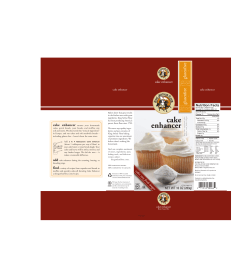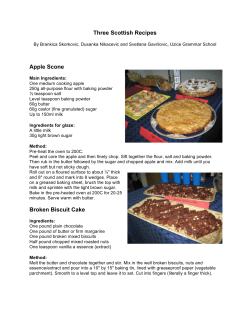
Document 85105
12/18/11 Shared flavor compounds show up on U.S. menus, rare in Asian cuisines: IU News Room: Indiana Uni… IU News Room IU News from all eight campuses Sunday, December 18, 2011 Last modified: Thursday, December 15, 2011 Shared flavor compounds show up on U.S. menus, rare in Asian cuisines FOR IMMEDIATE RELEASE Dec. 15, 2011 BLOOMINGTON, Ind. -- North Americans and Western Europeans love a good mix of alphaterpineol, 4-methylpentanoic acid and ethyl propionate for dinner, flavor compounds shared in popular ingredients like tomatoes, parmesan cheese and white wine. Authentic East Asian recipes, on the other hand, tend to avoid mixing ingredients with many shared flavor compounds, according to new complex networks research from Indiana, Harvard, Cambridge and Northeastern universities. (http://newsinfo.iu.edu/asset/page/normal/12990.html) Each node denotes an ingredient, the node color indicates food category, and node size reflects the ingredient prevalence in recipes. Two ingredients are connected if they share a significant number of flavor compounds, link thickness representing the number of shared compounds between the two ingredients. newsinfo.iu.edu/news/page/normal/20686.html 1/3 12/18/11 Shared flavor compounds show up on U.S. menus, rare in Asian cuisines: IU News Room: Indiana Uni… Adjacent links are bundled to reduce clutter. Print-Quality Photo (http://newsinfo.iu.edu/asset/page/normal/12990.html) In a search to uncover the patterns and principles people use in choosing ingredient combinations beyond individual taste and recipes, a team that included Indiana University Bloomington School of Informatics and Computing Assistant Professor Yong-Yeol Ahn looked at the key ingredients of 56,498 online recipes and then analyzed those ingredients for shared flavor compounds. The recipes came from three online recipe repositories: epicurious.com and allrecipes.com from the U.S. and the Korean menupan.com. Over the past decades, some food scientists and chefs have developed a food pairing hypothesis which states that ingredients sharing flavor compounds are more likely to taste good together than ingredients that do not. Some application of this can be found at contemporary restaurants that successfully pair white chocolate and caviar, ingredients that both contain trimethylamine and other flavor compounds, or chocolate and blue cheese, which share at least 73 flavor compounds. Ahn, who is also affiliated with the Center for Complex Networks and Systems Research operated by SOIC and IU's Pervasive Technology Institute, said that by creating a flavor network that captures the flavor compounds shared by culinary ingredients, the team could reformulate the food pairing hypothesis into a hypothesis on the graph-topological properties of recipes in the flavor network. Statistical tests can then be used to unveil the connectedness, or the lack thereof, of ingredients and flavor compounds. In this case, they took 381 ingredients from the group of recipes, along with an associated 1,021 flavor compounds that contributed flavor to those ingredients, and created a flavor network where ingredients are connected if they share at least one flavor compound. "What we showed was that the recipes in North American cuisine tend to share more flavor compounds than expected. The most authentic ingredient pairs and triplets in North American cuisine also tend to share multiple flavor compounds, while compound-sharing links are rare among the most authentic combinations in East Asian cuisine," Ahn said. Their analysis also referenced that the number of actual recipes in use, on the order of about 106, was tiny when compared to the large number of potential recipes (over 1,015). "We identified frequently used ingredients that contributed positively to the food pairing effect in North American cuisine, like milk, butter, cocoa, vanilla, cream and eggs," Ahn said. "These played a disproportionate role, as 13 key ingredients that contributed to a shared compound effect were found in 74.4 percent of North American recipes." There were also ingredients in East Asian cuisine -- beef, ginger, pork, cayenne, chicken and onion -newsinfo.iu.edu/news/page/normal/20686.html 2/3 12/18/11 Shared flavor compounds show up on U.S. menus, rare in Asian cuisines: IU News Room: Indiana Uni… that were the top contributors to an overall negative shared compound effect on food pairing. One future goal of the research would be to build an accessible infrastructure using more detailed datasets that incorporate the quantity information of flavor compounds, again advancing the use of data-driven network analysis methods that have transformed biology and the social sciences to yield new insights into food science. Another interesting venue of research is studying the evolution of recipes. A recently published recipeevolution model suggested that the staple ingredients consist of old ingredients (founders) and highly "fit" ingredients. "Among highly prevalent ingredients, we can see old ingredients that have been used in the same geographic region for thousands of years," Ahn said. "Yet there are also relatively new ingredients like tomatoes, potatoes and peppers that were introduced to Europe and Asia just a few hundred years ago. Though new, they are now staple ingredients." Co-authors on the paper with Ahn were Sebastian E. Ahnert of Northeastern and Cambridge, and James P. Bagrow and Albert-László Barabási, both of Northeastern and Harvard. Like the other authors, Ahn is also affiliated with the Northeastern Department of Physics' Center for Complex Network Research, and like Ahnert and Barabási, with Harvard's Dana-Farber Cancer Institute Center for Cancer Systems Biology. Published today, Dec. 15, in Scientific Reports as "Flavor network and the principles of food pairing (http://www.nature.com/srep/2011/111215/srep00196/full/srep00196.html) ," the research was supported by the James S. McDonnell Foundation 21st Century Initiative in Studying Complex Systems. For more information contact Steve Chaplin, Indiana University Communications, at 812-856-1896 or stjchap@iu.edu (mailto:stjchap@iu.edu) . Tweeting Indiana University science news: @IndianaScience (https://twitter.com/#!/IndianaScience) Copyright © 2010 The Trustees of Indiana University | Copyright Complaints newsinfo.iu.edu/news/page/normal/20686.html 3/3
© Copyright 2025

















